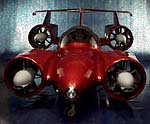
If you're like me: gadget-obsessed, interested in technology, raised on cartoons and sci-fi films, you probably look around you occasionally and complain, "Hey! It's 2006! Where the hell is my personal robot and flying car?"
Well, even with all the advances in technology, you're still going to have to wait a bit for a mechanical pal that will bring you another "Tab Energy" and fluff your pillow.
The flying car might not be so far off. Providing you've got the money to spend, of course.
Moller International has developed the first and only feasible, personally affordable, personal vertical takeoff and landing (VTOL) vehicle the world has ever seen.Emphasis mine. Take that "personally affordable" with a grain of salt. Like, one the size of a medicine ball. More on that later.
You've always known it was just a matter of time before the world demanded some kind of flying machine which would replace the automobile. Of course, this machine would have to be capable of VTOL, be easy to maintain, cost effective and reliable. Well, we at Moller International believe we have come up with the solution. That solution is the volantor named M400 Skycar.I love the word "volantor." Sounds like a chest-beating villain in a Conan movie. "I am Volantor! Son of Rofgor! Cringe in fear at the sight of my mighty club!"
Let's compare the M400 Skycar with what's available now, the automobile. Take the most technologically advanced automobile, the Ferrari, Porsche, Maserati, Lamborgini, or the more affordable Acura, Accord, or the like. It seems like all of the manufacturers of these cars are touting the new and greatly improved "aerodynamics" of their cars. Those in the aerospace industry have been dealing with aerodynamics from the start. In the auto industry they boast of aerodynamics, performance tuned wide track suspensions, electronic ignition and fuel injection systems, computer controllers, and the list goes on. What good does all this "advanced engineering" do for you when the speed limit is around 60 MPH and you are stuck on crowded freeways anyway?Okay. On more than one occasion, I have been driving along to witness someone talking on their cell phone, with their foot out the window while driving. This was insane at 40mph. Imagine if they were whizzing along at 275mph! Yeeks. These things had better come equipped with speaker phones.
Can any automobile give you this scenario? From your garage to your destination, the M400 Skycar can cruise comfortably at 275 MPH (maximum speed of 375 MPH) and achieve up to 20 miles per gallon on clean burning, ethanol fuel. No traffic, no red lights, no speeding tickets. Just quiet direct transportation from point A to point B in a fraction of the time. Three dimensional mobility in place of two dimensional immobility.
No matter how you look at it the automobile is only an interim step on our evolutionary path to independence from gravity. That's all it will ever be.
Moller International's M400 Skycar volantor is the next step.
 "Okay Paul," you say, "very funny, but what about the real concerns of safety with these things? Like, what if you're flying along, and run out of gas? Or an engine goes out? Well the Skycar people actually have a very large safety section on their site:
"Okay Paul," you say, "very funny, but what about the real concerns of safety with these things? Like, what if you're flying along, and run out of gas? Or an engine goes out? Well the Skycar people actually have a very large safety section on their site:There's also a large section on the car's dual parachutes. They seem to have done lots of work on the safety aspects of this flying car, which is encouraging. However, they seem to have forgotten the most important safety concern.
- Dual Engines -- In the unlikely event of an engine failure sufficient power remains to ensure a safe and comfortable landing. Since the M400 has eight engines, one or more can fail and the Skycar will still operate safely. Unlike any light helicopter or airplane, the M400 Skycar has four engine nacelles; each with two Rotapower engines. These computer-controlled engines operate independently and allow for a vertical controlled landing should one engine fail.
- Redundant Fuel Monitoring -- Multiple systems check fuel for quality and quantity and provide appropriate warnings.
- Enclosed Fans -- Each nacelle fully encloses the engines and fans, greatly reducing the possibility of injury to individuals near the aircraft. The volantor's VTOL lift is obtained via airflow through the four ducted fan propulsion nacelles which is redirected downward by deflection vanes during vertical takeoff.
The other drivers.
Frankly, with the way people drive, I don't know if we're ready to go whizzing around in the air. When most people can't be bothered to check their blind spot before changing lanes, do we really think anyone's going to be checking around themselves in every direction? Snark aside, this is pretty nifty. The gadget-head in me is delighted and drooling. I'm just not giving up terra-firma just yet.
Oh, and how much will a Skycar cost you? How about one million dollars?
(Up, up and away in my beautiful, my beautiful cross-post!)




Shakesville is run as a safe space. First-time commenters: Please read Shakesville's Commenting Policy and Feminism 101 Section before commenting. We also do lots of in-thread moderation, so we ask that everyone read the entirety of any thread before commenting, to ensure compliance with any in-thread moderation. Thank you.
blog comments powered by Disqus